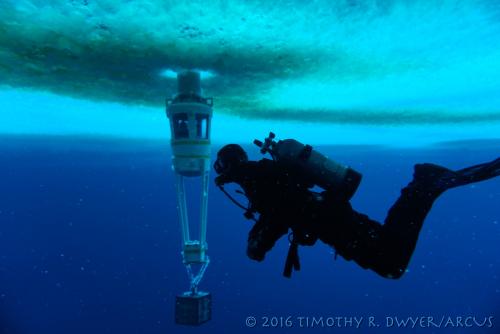 For non-divers the only means of looking beneath the ice is from a capsule sent from the world above.
For non-divers the only means of looking beneath the ice is from a capsule sent from the world above.
One of the recreation opportunities uniquely possible on an island in Antarctica is a visit to the sea ice observation tube. The "ob tube," as USAP participants affectionately refer to it, is a sort of reverse aquarium where the observers are on the inside, and the sea life is on the outside. McMurdo Station's proximity to the frozen Ross Sea is what makes this possible because the ob tube is basically a huge steel cylinder with a glass capsule at one end, pushed through a hole in the 7ft/2m thick ice. It's prevented from sinking through by steel girders on the surface that distribute the weight over the ice. For the non-diving adventurers among us, it's a way to get a glimpse of an otherwise unseen world.
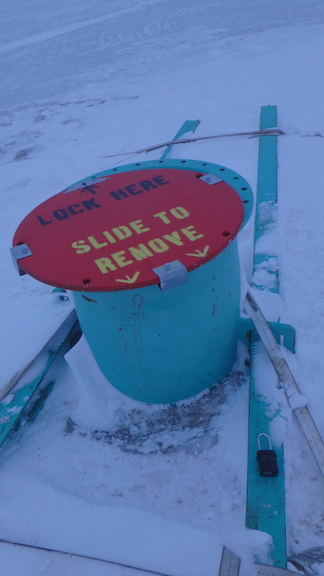 The somewhat forbidding support structure and entrance to the ob tube.
The somewhat forbidding support structure and entrance to the ob tube.
Local lore says that the ob tube was initially designed and built as an instrument of science sometime in the 1960s and has since been repurposed for Station recreation. The capsule itself is unheated, unpowered, and otherwise silent, so it seems like it would make an excellent tool for studying seal behavior underwater. Taking off my bulky "Big Red" parka and climbing down the narrow tunnel to the small stool below, I can hear the distant chirps and whistles of a Weddell seal reverberating against the steel. It's actually nice to listen without the sounds of my own scuba regulator's exhalations and I immediately see the attraction of the solitude (there's only enough space for one in the ob tube). However, remembering the excited expressions people in the ob tube have shown on occasions when I've swam by on scuba gear, I'm also grateful for the freedom of movement through the environment that the dive gear provides.
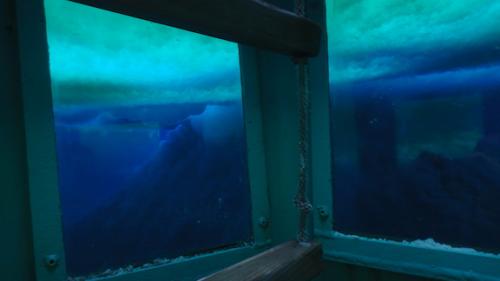 The views of the sea ice formations once inside the ob tube are spectacular!
The views of the sea ice formations once inside the ob tube are spectacular!
Installing and removing the ob tube is a significant project requiring the efforts of members of Fleet Operations (who drill the hole and lower it into the ice) and firefighters (who make sure it is safe). Moreover, they do this on their free time - typically a Sunday in October - as a service to the McMurdo Community. Occasionally, the tight space and 15ft/5m vertical climb out is too much for someone and firefighters have to pull them out. For that reason, they periodically practice "egressing" a person from the enclosed space. Still, visiting the ob tube is just one more of the interesting little perks that come with life down here. From our nearby dive hut, the numerous people we see waiting in line for their turn are a testament to the ob tube's importance to Station morale. The ob tube is arguably unique in Antarctica and is part of living a life less ordinary, a life that attracts many to travel and work so far from home.
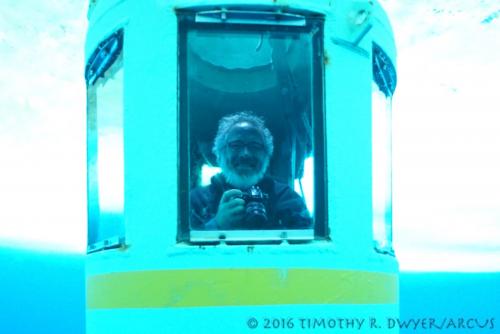 Artist and Writers Fellow Prof. Glenn McClure draws inspiration from observing divers from inside the ob tube.
Artist and Writers Fellow Prof. Glenn McClure draws inspiration from observing divers from inside the ob tube.
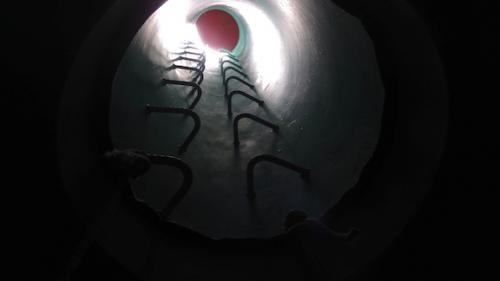 The way out requires a little climbing skill and no fear of enclosed spaces.
The way out requires a little climbing skill and no fear of enclosed spaces.

Comments